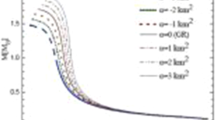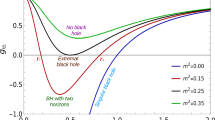Abstract
THE discovery of pulsars and the general conviction that they are neutron stars resulting from gravitational collapse have strengthened the belief in the possible presence of Schwarzschild black-holes—or Schwarzschild horizons—in nature, the latter being the ultimate stage in the progressive spherical collapse of a massive star. The stability of these objects, which has been discussed in a recent report1, ensures their continued existence after formation. Inasmuch as the infinite redshift associated with it and its behaviour as a one-way membrane make the Schwarzschild horizon at once elusive and intriguing, it is important to explore theoretically all possible modes in which the presence of such a black-hole manifests itself. In what follows, we present a partial summary of some results obtained from an investigation of the scattering of gravitational waves by a Schwarzschild horizon.
Similar content being viewed by others
References
Vishveshwara, C. V., Phys. Rev. (1970, in the press).
Regge, T., and Wheeler, J. A., Phys. Rev., 108, 1903 (1957).
Edelstein, L. A., and Vishveshwara, C. V., Phys. Rev. (1970, in the press).
Edelstein, L. A., thesis, University of Maryland (1970).
Author information
Authors and Affiliations
Rights and permissions
About this article
Cite this article
VISHVESHWARA, C. Scattering of Gravitational Radiation by a Schwarzschild Black-hole. Nature 227, 936–938 (1970). https://doi.org/10.1038/227936a0
Received:
Issue Date:
DOI: https://doi.org/10.1038/227936a0
- Springer Nature Limited
This article is cited by
-
Quasinormal modes of C-metric from SCFTs
Journal of High Energy Physics (2024)
-
Conformal Ricci solitons on Vaidya spacetime
General Relativity and Gravitation (2024)
-
Quasi-normal modes of Ayon–Beato Garcia regular black holes for scalar field
Indian Journal of Physics (2023)
-
Quasinormal Modes of AdS Black Strings
Indian Journal of Physics (2023)
-
Gauge invariant perturbations of general spherically symmetric spacetimes
Science China Physics, Mechanics & Astronomy (2023)





